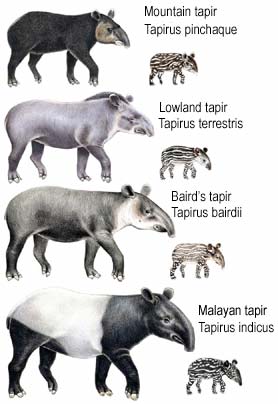Trivia question for Mar-06-2011
Carter picked this odd looking mammal because of the fact that they are becoming more and more rare and because he said they looked so cool. So here we go. The main threat to these guys is human activity, including deforestation for agricultural purposes, flooding caused by the damming of rivers for hydroelectric projects, and illegal trade. In some countries for instance, capture and sale of one of these young animals may be worth US$5500.00
In areas where the population is predominantly Muslim, these guys are seldom hunted for food, as their physical similarity to pigs has made their meat a taboo, but in some regions they are hunted for sport or shot accidentally when mistaken for other animals. They usually prefer to live near water and often bathe and swim, and they are also able to climb steep slopes. They are mainly active at night, though they are not exclusively nocturnal.
So here are Carter’s question. Tell us what this species is and where they live, and also tell us how these guys communicate with each other. You might want to double check you answer before you hit the submit button since there are various types of these species and the one pictured lives only in one area.
Good Luck 😉
Answer:
Congratulations to Natalie for getting all the answers correct. Good thing she double checked first because their are several types of these guys. The portly looking critter we featured is the Malayan Tapir. The Malayan Tapir, also called the Asian Tapir, is the largest of the four species of tapir and the only one native to Asia. The scientific name refers to the East Indies, the species’ natural habitat. In the Malay language, the tapir is commonly referred to as “cipan”, “tenuk” or “badak tampong”.
 Here is a chart which shows the four types of Tapir and how you can tell them apart. You will notice that the babies of all for types sport distinct camouflage makings which help protect them while foraging through the forest with their parents. As they get older, their markings change to best suit the appropriate surroundings of the regional homeland.
Here is a chart which shows the four types of Tapir and how you can tell them apart. You will notice that the babies of all for types sport distinct camouflage makings which help protect them while foraging through the forest with their parents. As they get older, their markings change to best suit the appropriate surroundings of the regional homeland.
The Malayan tapir has very poor eyesight, and making them rely greatly on their excellent sense of smell and hearing to go about in their everyday lives. The Malayan tapir has small, beady eyes with brown irises on either side of their face. Their eyes are often covered in a blue haze, which is corneal cloudiness thought to be caused by repetitive exposure to light. The Malayan Tapir was once found throughout the tropical lowland rainforests of Southeast Asia, including Cambodia, Indonesia, Laos, Malaysia, Myanmar (Burma), Thailand, and Vietnam. However, its numbers have decreased in recent years, and today, like all tapirs, it is in danger of extinction. Because of their size, tapirs have few natural predators, and even reports of killings by tigers are scarce.
Here is more on our Black and White friend: Malayan Tapir
Thanks for playing along 😉

